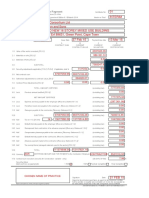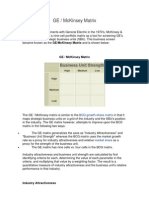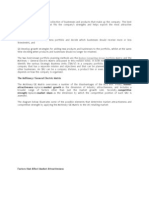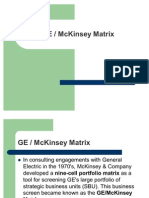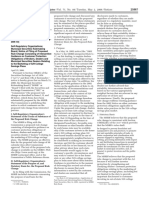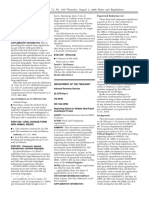GE - McKinsey Matrix - ADK
GE - McKinsey Matrix - ADK
Uploaded by
SAERO9Copyright:
Available Formats
GE - McKinsey Matrix - ADK
GE - McKinsey Matrix - ADK
Uploaded by
SAERO9Original Description:
Original Title
Copyright
Available Formats
Share this document
Did you find this document useful?
Is this content inappropriate?
Copyright:
Available Formats
GE - McKinsey Matrix - ADK
GE - McKinsey Matrix - ADK
Uploaded by
SAERO9Copyright:
Available Formats
Strategic Management
GE / McKinsey Matrix
In consulting engagements with General Electric in the 1970's, McKinsey & Company developed a
nine-cell portfolio matrix as a tool for screening GE's large portfolio of strategic business units
(SBU). This business screen became known as the GE/McKinsey Matrix and is shown below
GE I McKinsey Matrix
The GE / McKinsey matrix is similar to the BCG growth-share matrix in that it maps strategic
business units on a grid of the industry and the SBU's position in the industry. The GE matrix
however, attempts to improve upon the BCG matrix in the following two ways:
1. The GE matrix generalizes the axes as "Industry Attractiveness" and "Business Unit Strength"
whereas the BCG matrix uses the market growth rate as a proxy for industry attractiveness and
relative market share as a proxy for the strength of the business unit.
2. The GE matrix has nine cells vs. four cells in the BCG matrix.
Industry attractiveness and business unit strength are calculated by first identifying criteria for
each, determining the value of each parameter in the criteria, and multiplying that value by a
weighting factor. The result is a quantitative measure of industry attractiveness and the business
unit's relative performance in that industry.
Industry Attractiveness
The vertical axis of the GE / McKinsey matrix is industry attractiveness, which is determined by
factors such as the following:
Market growth rate
Market size
Demand variability
Industry profitability
Industry rivalry
Global opportunities
Macro-environmental factors (PEST)
Business Unit Strength
The horizontal axis of the GE / McKinsey matrix is the strength of the business unit. Some factors
that can be used to determine business unit strength include:
Market share
Growth in market share
Brand equity
Distribution channel access
Production capacity
Profit margins relative to competitors
The business unit strength index can be calculated by multiplying the estimated value of each
factor by the factor's weighting, as done for industry attractiveness.
Plotting the Information
Each business unit can be portrayed as a circle plotted on the matrix, with the information
conveyed as follows:
Market size is represented by the size of the circle.
Market share is shown by using the circle as a pie chart.
The expected future position of the circle is portrayed by means of an arrow.
Each factor is assigned a weighting that is appropriate for the industry.
You might also like
- Creating Shareholder Value: A Guide For Managers And InvestorsFrom EverandCreating Shareholder Value: A Guide For Managers And InvestorsRating: 4.5 out of 5 stars4.5/5 (9)
- Data-Driven Marketing: The 15 Metrics Everyone in Marketing Should KnowFrom EverandData-Driven Marketing: The 15 Metrics Everyone in Marketing Should KnowRating: 3.5 out of 5 stars3.5/5 (19)
- GE MatrixDocument6 pagesGE MatrixkhumiNo ratings yet
- Canadian County Appointed Counsel ApplicationDocument6 pagesCanadian County Appointed Counsel ApplicationDannyNo ratings yet
- International Finance BookDocument742 pagesInternational Finance BookCristina Cp100% (2)
- Ge MatrixDocument12 pagesGe Matrixtony_njNo ratings yet
- I3T3 MEGA WEBINAR - 3 & 4 Module - Advanced Price Action TradingDocument3 pagesI3T3 MEGA WEBINAR - 3 & 4 Module - Advanced Price Action TradingLive NIfty0% (1)
- Procedures in Computing Interest On Capital and Patronage in CooperativesDocument29 pagesProcedures in Computing Interest On Capital and Patronage in CooperativesAr-Ar Toledo100% (1)
- SACAP - PPE PBA Payment Certificate (March 2015)Document1 pageSACAP - PPE PBA Payment Certificate (March 2015)Ben MusimaneNo ratings yet
- Business Plan ProposalDocument8 pagesBusiness Plan ProposalAirah Mondonedo100% (2)
- Ge/Mckinsey MatrixDocument1 pageGe/Mckinsey MatrixNashiba MasturaNo ratings yet
- GE - McKinsey MatrixDocument4 pagesGE - McKinsey MatrixmohitNo ratings yet
- GE - McKinsey MatrixDocument3 pagesGE - McKinsey MatrixPankaj Kumar100% (1)
- Business Unit Strength: Quickmba StrategyDocument4 pagesBusiness Unit Strength: Quickmba StrategymysterioussurferNo ratings yet
- Ge MatrixDocument3 pagesGe MatrixSantosh JhawarNo ratings yet
- OverviewDocument1 pageOverviewniharikasingh000No ratings yet
- GE MatrixDocument6 pagesGE MatrixManish JhaNo ratings yet
- STG MNGMNTDocument10 pagesSTG MNGMNTChandan DevNo ratings yet
- Ge MatrixDocument4 pagesGe MatrixhaiderhusainNo ratings yet
- BCG GrowthDocument5 pagesBCG GrowthAmol NirgudkarNo ratings yet
- Ge / Mckinsey MatrixDocument4 pagesGe / Mckinsey MatrixVishh ChennNo ratings yet
- General Electric (Ge) Mckinsey & Company Boston Consulting Group (BCG) Portfolio AnalysisDocument4 pagesGeneral Electric (Ge) Mckinsey & Company Boston Consulting Group (BCG) Portfolio AnalysisMaaryaAslamNo ratings yet
- GE - McKinsey Matrix - ADKDocument3 pagesGE - McKinsey Matrix - ADKViz PrezNo ratings yet
- GE MatrixDocument15 pagesGE MatrixFijo JoseNo ratings yet
- BCG Growth-Share MatrixDocument9 pagesBCG Growth-Share MatrixSaurabh ShuklaNo ratings yet
- GE MatrixDocument15 pagesGE Matrixsatyadarshi ravi singh100% (1)
- General Ele 9 CellDocument15 pagesGeneral Ele 9 CellAryan SinghNo ratings yet
- GE Matrix-MujtabaDocument3 pagesGE Matrix-Mujtabaahmadmujtaba005No ratings yet
- Attractiveness Factor 2 Value by Factor 2 Weighting, Etc. Factor 2 Value by Factor 2 Weighting, EtcDocument2 pagesAttractiveness Factor 2 Value by Factor 2 Weighting, Etc. Factor 2 Value by Factor 2 Weighting, EtcIssa VandanaNo ratings yet
- The BCG Matrix and GE9 MatrixDocument5 pagesThe BCG Matrix and GE9 MatrixAnshul MangalNo ratings yet
- Product Strategy Tools - GE - McKinsey Portfolio MatrixDocument5 pagesProduct Strategy Tools - GE - McKinsey Portfolio MatrixSASI KUMAR SUNDARA RAJANNo ratings yet
- GE - Matrix, Aziz Ali AfzalyDocument6 pagesGE - Matrix, Aziz Ali Afzalyali afzalyNo ratings yet
- GE - Matrix, Aziz Ali AfzalyDocument6 pagesGE - Matrix, Aziz Ali Afzalyali afzalyNo ratings yet
- GE MatrixDocument2 pagesGE MatrixMAHENDRA SHIVAJI DHENAKNo ratings yet
- Product and Brand Managemet AssignmentDocument6 pagesProduct and Brand Managemet Assignmentali afzalyNo ratings yet
- Product Strategy Tools GE MatrixDocument5 pagesProduct Strategy Tools GE MatrixWaseem AbbasNo ratings yet
- BCG Matrix: Individual Sale This Year - Individual Sale Last Year Individual Sale Last YearDocument12 pagesBCG Matrix: Individual Sale This Year - Individual Sale Last Year Individual Sale Last YearRitika DiwakarNo ratings yet
- Ge 9-CellpptDocument11 pagesGe 9-CellpptjonyshakyaNo ratings yet
- GE Multifactor Portfolio Matrix:-: Strategy FormulationDocument4 pagesGE Multifactor Portfolio Matrix:-: Strategy FormulationHemant TejwaniNo ratings yet
- NotesDocument10 pagesNotesvarun rajNo ratings yet
- GE McKinsey Matrix - The Ultimate Guide - SM InsightDocument18 pagesGE McKinsey Matrix - The Ultimate Guide - SM Insightsahar50sabryNo ratings yet
- McKinsey GEC MatrixDocument5 pagesMcKinsey GEC MatrixFaiz Kazi100% (1)
- GE MatrixDocument12 pagesGE MatrixArun ChidambaramNo ratings yet
- Gec Model Industry AnalysisDocument3 pagesGec Model Industry AnalysisHina Singhvi0% (1)
- Ge Matrix: Presented By: Sadia Nasir Student Id: 20181-23584Document18 pagesGe Matrix: Presented By: Sadia Nasir Student Id: 20181-23584Hassan AhmedNo ratings yet
- GE MatrixDocument6 pagesGE Matrixmax_dcosta0% (2)
- GE McKinsey MatrixDocument14 pagesGE McKinsey MatrixSASI KUMAR SUNDARA RAJANNo ratings yet
- BCG Matrix & GE - McKinsey Matrix - CI-wikiDocument10 pagesBCG Matrix & GE - McKinsey Matrix - CI-wikiNamrita Gupta0% (1)
- Ge MckinseyDocument9 pagesGe MckinseyAnjaliMoreNo ratings yet
- Module III - GE Nine Cell MatrixDocument19 pagesModule III - GE Nine Cell MatrixloganathprasannaNo ratings yet
- GE Nine MatrixDocument9 pagesGE Nine MatrixSiddhartha GhoshNo ratings yet
- WEEK 6 Rizal Iza TigonDocument6 pagesWEEK 6 Rizal Iza TigonVanesa AgootNo ratings yet
- GE 9 CellDocument20 pagesGE 9 CellakhilNo ratings yet
- The BCG MatrixDocument7 pagesThe BCG MatrixdeepthykNo ratings yet
- GE MatrixDocument3 pagesGE Matrixr.jeyashankar9550No ratings yet
- GE Nine Cell & Strategic EthicsDocument15 pagesGE Nine Cell & Strategic EthicsPratyay DasNo ratings yet
- GE MatrixDocument26 pagesGE MatrixFijo JoseNo ratings yet
- Ge 9cellDocument2 pagesGe 9cellSimran JoharNo ratings yet
- BCG and GeDocument16 pagesBCG and GekaurmaanNo ratings yet
- McKinsey Model PortfolioDocument3 pagesMcKinsey Model PortfolioAbhay SuryNo ratings yet
- Marketing Matters: A Market Analysis Methodology Leading to a Marketing Simulation CapabilityFrom EverandMarketing Matters: A Market Analysis Methodology Leading to a Marketing Simulation CapabilityNo ratings yet
- Fuel Pumps & Fuel Tanks (Car OE & Aftermarket) World Summary: Market Values & Financials by CountryFrom EverandFuel Pumps & Fuel Tanks (Car OE & Aftermarket) World Summary: Market Values & Financials by CountryNo ratings yet
- Business Intelligence Questions, Analytical & Reporting HintFrom EverandBusiness Intelligence Questions, Analytical & Reporting HintNo ratings yet
- Manifold Business Forms World Summary: Market Sector Values & Financials by CountryFrom EverandManifold Business Forms World Summary: Market Sector Values & Financials by CountryNo ratings yet
- Starter Motors & Parts (Car OE & Aftermarket) World Summary: Market Values & Financials by CountryFrom EverandStarter Motors & Parts (Car OE & Aftermarket) World Summary: Market Values & Financials by CountryNo ratings yet
- Inventory Management Project ReportDocument77 pagesInventory Management Project ReportBabasab Patil (Karrisatte)67% (6)
- Invoice 2009780649 08 10 10Document2 pagesInvoice 2009780649 08 10 10Irfan FarooqNo ratings yet
- What Is TDS?: When and How To Deduct TDS?Document12 pagesWhat Is TDS?: When and How To Deduct TDS?Michael WellsNo ratings yet
- Jualan Promosi Gempak Jalan Ketapang Taman Rinting Masai FULL LOANDocument2 pagesJualan Promosi Gempak Jalan Ketapang Taman Rinting Masai FULL LOANZuhairi ZakariaNo ratings yet
- Capital Structure - ULTRATECHDocument18 pagesCapital Structure - ULTRATECHMohmmedKhayyumNo ratings yet
- Burger King India DRHPDocument23 pagesBurger King India DRHPBikash KumarNo ratings yet
- Business PlanDocument62 pagesBusiness PlanJoshua GobrinNo ratings yet
- FIN 004 Module 2 PPT Part 1Document2 pagesFIN 004 Module 2 PPT Part 1lianna marieNo ratings yet
- Depreciation MCQDocument10 pagesDepreciation MCQamitsukhija2009No ratings yet
- Interest Rates TableDocument12 pagesInterest Rates TableRahulNo ratings yet
- Notice: Self-Regulatory Organizations Proposed Rule Changes: Municipal Securities Rulemaking BoardDocument9 pagesNotice: Self-Regulatory Organizations Proposed Rule Changes: Municipal Securities Rulemaking BoardJustia.comNo ratings yet
- 65 (1) Senet Degree 2022 23 For Online ApplicationDocument8 pages65 (1) Senet Degree 2022 23 For Online ApplicationAkbarhusain MominNo ratings yet
- Tax Ch02Document10 pagesTax Ch02GabriellaNo ratings yet
- dv01 White Paper NQM Prepayment ModelDocument20 pagesdv01 White Paper NQM Prepayment ModelsinhaagmailNo ratings yet
- Acc 106 Quiz BR and Ar NoakDocument8 pagesAcc 106 Quiz BR and Ar Noakhoneyjoy salapantanNo ratings yet
- Guide To Community Services 2011Document44 pagesGuide To Community Services 2011monroecountybeaconNo ratings yet
- Project Report On Lic IndiaDocument72 pagesProject Report On Lic IndiagauravNo ratings yet
- Enumerations and Req ObliconDocument4 pagesEnumerations and Req ObliconSofia DavidNo ratings yet
- Mumbai - Fast Track CFP Exam 5 (Final Exam) Preparation Training Workshop - 09th and 10th JuneDocument3 pagesMumbai - Fast Track CFP Exam 5 (Final Exam) Preparation Training Workshop - 09th and 10th Junekeyur1975No ratings yet
- NOCHE BUENA NA SIRDocument4 pagesNOCHE BUENA NA SIRpatriciaannedelosreyesdelacruzNo ratings yet
- Statement of Work (SPI X YONDU)Document5 pagesStatement of Work (SPI X YONDU)Luigi Marvic FelicianoNo ratings yet
- Rule: Income Taxes: Widely Held Fixed Investment Trusts Reporting RequirementsDocument6 pagesRule: Income Taxes: Widely Held Fixed Investment Trusts Reporting RequirementsJustia.comNo ratings yet
- Cw-Invoices Invoice 6730051 CWI1903736 Gif4us PDFDocument1 pageCw-Invoices Invoice 6730051 CWI1903736 Gif4us PDFManav SpoliaNo ratings yet
- Accounting Concepts and Priciples: Fundamentals of Accountancy, Business and Management 1Document10 pagesAccounting Concepts and Priciples: Fundamentals of Accountancy, Business and Management 1Marilyn Nelmida TamayoNo ratings yet








